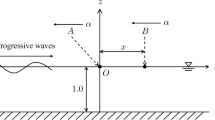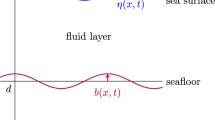Abstract
In this study, we present a linear inverse approach for the computation of the initial water displacement of a tsunami. The method uses empirical Green functions and linear shallow water wave theory. We apply this methodology to study the source of the 24 September 2013 tsunami off the Makran coast. We re-analyze the 2013 tsunami data, particularly the tide records in the coast of Oman and the DART buoy record in the Arabian Sea, to infer its source. We use wavelet and Fourier analyses to characterize the frequency content of the tide records and the possible influence of local harbor effects. We compute empirical Green functions for the possible source area, and then use a linear shallow water inversion technique to assess the water disturbance in the early stage of tsunami propagation. The comparison between forward modeling and observations shows a fair agreement with available data, particularly in what concerns the DART record. It also suggests the existence of local amplifications in a number of Omani harbors. The free surface elevation obtained by inversion of the waveforms is coherent with a landslide located close to 61.5° E, 24° N, sliding to the S or SSE direction. Our results show that the inversion technique used here leads to a better characterization of the tsunami source than the simple backward ray tracing which assumes a simple point source. In addition, these results strengthen the hypothesis that landslides might have played an important role in previous tsunami events in the area, and must be taken into account for tsunami hazard assessment on the Omani coast.








Similar content being viewed by others
References
Aida I (1972) Numerical estimation of a tsunami source, Zisin 2. J Seism Soc Jpn 25:343–352
Avouac JF, Ayoub SW, Ampuero JP, Lingsen M, Leprince S, Romain J, Zacharie Duputel Z, Helmberger D (2014) The 2013, Mw 7.7 Balochistan earthquake, energetic strike-slip reactivation of a thrust fault. Earth Planet Sci Lett 391:128–134
Baba T, Cummins R, Hori T (2005) Compound fault rupture during the 2004 off the Kii Peninsula earthquake (M 7.4) inferred from highly resolved coseismic sea-surface deformation. Earth Planet Space 57(3):167–172
Baptista MA, Miranda PM, Miranda JM, Victor LM (1998) Constrains on the source of the 1755 Lisbon tsunami inferred from numerical modelling of historical data on the source of the 1755 Lisbon tsunami. J Geodyn 25(1):159–174
Baptista MA, Omira R, Miranda JM, El Hussain I, Deif A, Habsi Z (2014) On the source of the 24 September 2013 tsunami in Oman Sea. In: EGU General Assembly Conference Abstracts, vol 16, p 6185
Baptista MA, Miranda JM, Batlló J, Lisboa F, Luis J, Maciá R (2016) New study on the 1941 Gloria Fault earthquake and tsunami. Nat Hazards Earth Syst Sci 16(8):1967–1977
Bilham R, Lodi S, Hough S, Bukhary S, Khan AM, Rafeeqi SFA (2007) Seismic hazard in Karachi, Pakistan: uncertain past, uncertain future. Seismol Res Lett 78(6):601–613
Byrne DE, Sykes LR, Davis DM (1992) Great thrust earthquakes and aseismic slip along the plate boundary of the Makran subduction zone. J Geophys Res 97(B1):449–478
Heidarzadeh M, Satake K (2014a) The 24 September 2013 tsunami in the Makran region, northwestern Indian Ocean. In: EGU General Assembly Conference Abstracts, vol 16, p 14627
Heidarzadeh M, Satake K (2014b) Possible sources of the tsunami observed in the northwestern Indian Ocean following the 2013 September 24 Mw 7.7 Pakistan inland earthquake. Geophys J Int 199(2):752–766
Hoffmann G, Al-Yahyai S, Naeem G, Kociok M, Grützner C (2014) An Indian Ocean tsunami triggered remotely by an onshore earthquake in Balochistan, Pakistan. Geology 42(10):883–886
Jolivet R, Duputel Z, Riel B, Simons M, Rivera L, Minson SE et al (2014) The 2013 M w 7.7 Balochistan earthquake: seismic potential of an accretionary wedge. Bull Seismol Soc Am 104(2):1020–1030
Koike N (2011) Estimation of tsunami initial displacement of water surface using inversion method with a priori information. INTECH Open Access Publisher, London
Liu PLF, Woo SB, and Cho YS (1998) Computer programs for tsunami propagation and inundation. Report to the National Science Foundation.
Luis JF (2007) MIRONE - a multi-purpose tool for exploring grid data. Comput Geosci 33:31–41
Menke W (2012) Geophys data analysis: discrete inverse theory, 3rd edn. Academic, Cambridge, p 293, ISBN 978-0-12-397160-9
Miranda JM, Luis JF, Reis C, Omira R, Baptista MA (2014a) Validation of NSWING, a multi-core finite difference code for tsunami propagation and run-up. Abstract S21A-4390 presented at 2014 Fall Meeting. AGU, San Francisco
Miranda JM, Baptista MA, Omira R (2014b) On the use of Green’s summation for tsunami waveform estimation: a case study. Geophys J Int 199(1):459–464
Mokhtari M, Fard IA, Hessami K (2008) Structural elements of the Makran region, Oman Sea and their potential relevance to tsunamigenesis. Nat Hazards 47(2):185–199
Mulia IE, Asano T (2015) Randomly distributed unit sources to enhance optimization in tsunami waveform inversion. Nat Hazards Earth Syst Sci 15:187–196
Neetu S, Suresh I, Shankar R, Nagarajan B, Sharma R, Shenoi SSC, Unnikrishnan AS, Sundar D (2011) Trapped waves of the 27 November 1945 Makran tsunami: observations and numerical modeling. Nat Hazards 59(3):1609–1618
Okal EA, Fritz HM, Raad PE, Synolakis CE, Al-Shijbi Y, Al-Saifi Y (2006) Oman field survey after the December 2004 Indian Ocean tsunami. Earthquake Spectra 22(S3):S203–S218
Pararas-Carayannis G (2006) The potential of tsunami generation along the Makran Subduction Zone in the northern Arabian Sea: case study: the earthquake and tsunami of November 28, 1945. Sci Tsunami Hazards 24(5):358–384
Pendse CG (1946) The Makran earthquake of the 28th November 1945. India Meteorol Depart Sci Notes 10(125):141–145
Rodriguez M, Chamot-Rooke N, Hébert H, Fournier M, Huchon P (2013) Owen ridge deep-water submarine landslides: implications for tsunami hazard along the Oman coast. Nat Hazards Earth Syst Sci 13:417–424. https://doi.org/10.5194/nhess-13-417-2013
Salamon A, Di Manna P (2019) Empirical constraints on magnitude-distance relationships for seismically-induced submarine tsunamigenic landslides. Earth-Sci Rev 191:66–92. https://doi.org/10.1016/j.earscirev.2019.02.001
Satake K, Toshitaka B, Kenji H, Shin-Iti I, Teruyuki K, Koshimura S, Takenaka J, Yukihiro T (2005) Tsunami source of the 2004 off the Kii Peninsula earthquakes inferred from offshore tsunami and coastal tide gauges. Earth Planet Space 57(3):173–178
Tang L, Titov VV, Wei Y, Mofjeld HO, Spillane M, Arcas D, Bernard EN, Chamberlin C, Gica E, Newman J (2008) Tsunami forecast analysis for the May 2006 Tonga tsunami. J Geophys Res 113(C12). https://doi.org/10.1029/2008JC004922
Tsushima H, Hino R, Fujimoto H, Tanioka Y, Imamura F (2009) Near-field tsunami forecasting from cabled ocean bottom pressure data. J Geophys Res Solid Earth (1978–2012) 114(B6)
Wu TR, Ho TC (2011) High resolution tsunami inversion for 2010 Chile earthquake. Nat Hazards Earth Syst Sci 11(12):3251–3261
Yasuda T, Mase H (2013) Real-time tsunami prediction by inversion method using offshore observed GPS buoy data: Nankaido. J Waterw Port Coast Ocean Eng 139(3):221–231
Acknowledgments
All figures were prepared with MIRONE suite (Luis 2007). All data used in this study is available at the following websites: http://www.ioc-sealevelmonitoring.org, http://www.ngdc.noaa.gov/dart, http://www.gebco.net/data_and_products/gridded_bathymetry_data.
Funding
This work was funded by the Portuguese Science and Technology Foundation project MAGICLAND – Marine-Geohazards Induced by underwater landslides in SW Iberian Margin (Ref: PTDC/CTA-GEO/30381/2017) and received financial support FCT through project UIDB/50019/2020 – IDL.
Author information
Authors and Affiliations
Corresponding author
Additional information
This article is part of the Topical Collection on Seismic and Earthquake Engineering Studies in the Arabian Plate and the Surrounding Region
Rights and permissions
About this article
Cite this article
Baptista, M.A., Miranda, J.M., Omira, R. et al. Study of the 24 September 2013 Oman Sea tsunami using linear shallow water inversion. Arab J Geosci 13, 606 (2020). https://doi.org/10.1007/s12517-020-05632-z
Received:
Accepted:
Published:
DOI: https://doi.org/10.1007/s12517-020-05632-z




